Thai Beverage Bundle
How did Thai Beverage Company become a beverage giant?
Embark on a journey through the Thai Beverage SWOT Analysis, exploring the remarkable rise of ThaiBev from its roots in the Thai alcohol industry to its current status as a regional powerhouse. Uncover the strategic brilliance behind the creation of Chang beer and the consolidation that shaped its destiny. Learn about the early days of Thai Beverage and how it transformed into a diversified conglomerate.
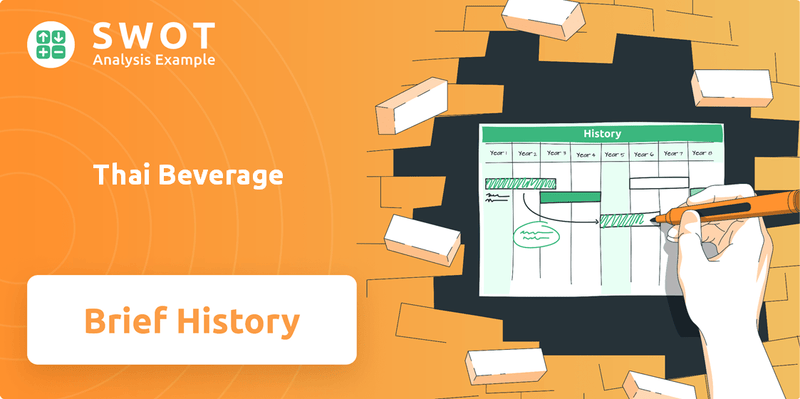
The History of ThaiBev is a compelling narrative of strategic foresight and market adaptation. From its founding in 2003, the company has demonstrated an unwavering commitment to growth, expanding its product portfolio and market share across Southeast Asia and beyond. Understanding the ThaiBev company profile reveals key insights into its operational success and its enduring impact on Thailand's economy.
What is the Thai Beverage Founding Story?
The founding of Thai Beverage Public Company Limited (ThaiBev) on October 29, 2003, marked a significant consolidation within the Thai alcohol industry. This strategic move brought together several established spirits and beer businesses under one umbrella. Charoen Sirivadhanabhakdi, a Thai billionaire, spearheaded this initiative, leveraging his extensive business experience to create a major player in the beverage market.
Charoen's vision was to unify various alcohol businesses to enhance efficiency and market control. His background in real estate and hospitality, combined with a deep understanding of consumer markets, enabled him to identify the potential for a consolidated beverage conglomerate. This consolidation aimed to capitalize on the existing strong brands and the growing consumer market in Thailand.
The initial focus was on the production and distribution of alcoholic beverages, including spirits and beer. Key products like Chang Beer quickly became central to the company's offerings. The financial foundation for ThaiBev came from Charoen's existing business ventures, allowing the new entity to immediately secure a substantial market share. The timing was opportune, with a rising middle class and established social norms around alcohol consumption providing a favorable environment for growth. For more information on the company's consumer base, you can read about the Target Market of Thai Beverage.
Here are some key aspects of ThaiBev's founding:
- Strategic Consolidation: ThaiBev was formed by consolidating several existing spirits and beer businesses.
- Leadership: Charoen Sirivadhanabhakdi, a prominent Thai businessman, was the driving force behind the company's creation.
- Initial Focus: The company's early offerings included spirits and beer, with brands like Chang Beer playing a crucial role.
- Funding: The initial funding came from Charoen's existing business assets, allowing for immediate market presence.
Thai Beverage SWOT Analysis
- Complete SWOT Breakdown
- Fully Customizable
- Editable in Excel & Word
- Professional Formatting
- Investor-Ready Format
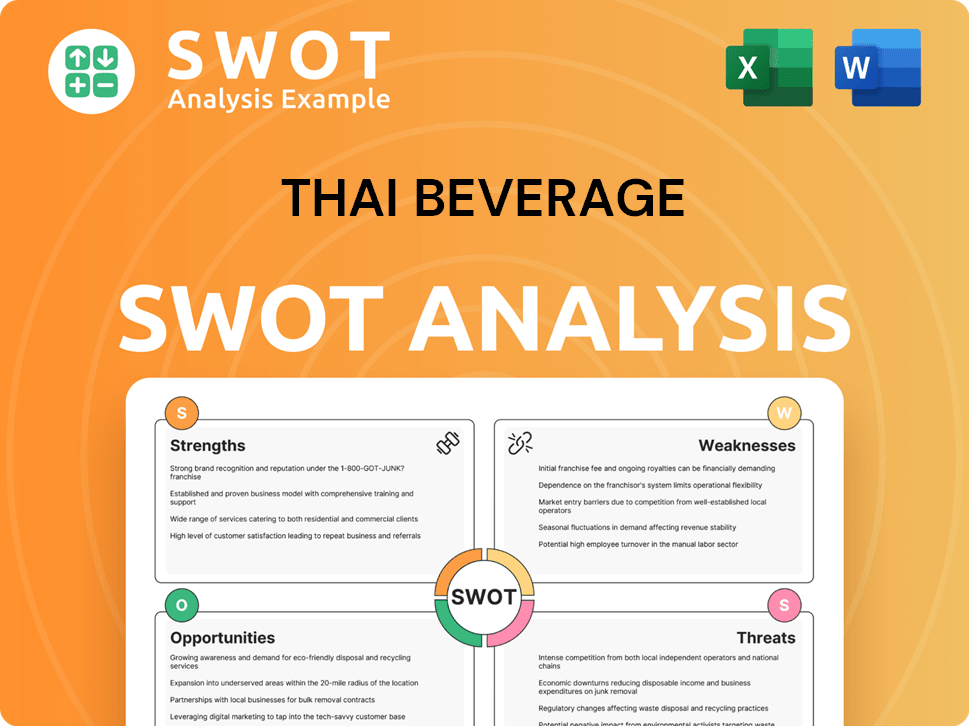
What Drove the Early Growth of Thai Beverage?
Following its establishment in 2003, Thai Beverage Company, or ThaiBev, swiftly expanded, becoming a major player in Southeast Asia's beverage market. This early growth phase involved leveraging existing brands like Chang Beer and traditional Thai spirits. The company focused on integrating operations and improving distribution across Thailand.
Early product launches capitalized on the strong brand recognition of Chang Beer and other established spirits within the Thai alcohol industry. These products quickly achieved substantial sales milestones, solidifying ThaiBev's market presence. The focus was on building brand loyalty and expanding market reach within Thailand.
Initial team expansion concentrated on integrating the operations of the consolidated businesses. This included streamlining production processes and enhancing distribution networks throughout the country. The goal was to improve efficiency and ensure smooth operations across the growing enterprise.
A key aspect of ThaiBev's early growth was entering new markets and product categories. Beyond alcoholic beverages, the company diversified into non-alcoholic segments, such as ready-to-drink tea and coffee. This strategy aimed to cater to evolving consumer preferences and reduce reliance on a single product category.
Strategic acquisitions and mergers played a crucial role in ThaiBev's expansion. The acquisition of Sermsuk Public Company Limited significantly boosted its non-alcoholic portfolio. Major capital raises, including its listing on the Singapore Exchange (SGX) in 2006, provided funds for aggressive expansion.
Thai Beverage PESTLE Analysis
- Covers All 6 PESTLE Categories
- No Research Needed – Save Hours of Work
- Built by Experts, Trusted by Consultants
- Instant Download, Ready to Use
- 100% Editable, Fully Customizable
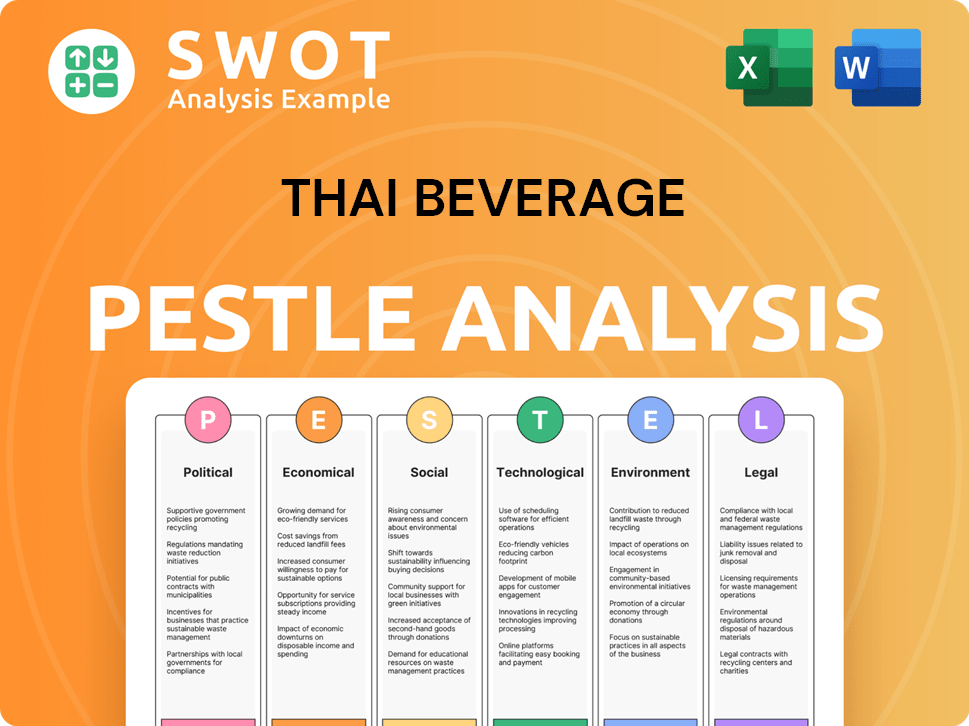
What are the key Milestones in Thai Beverage history?
The History of Thai Beverage Company has been marked by significant achievements and strategic moves. From its inception, the company has expanded its reach and diversified its portfolio, establishing itself as a key player in the beverage industry. The evolution of the company reflects its adaptability and strategic vision in navigating the complexities of the market.
| Year | Milestone |
|---|---|
| 1960s | The initial establishment of breweries and distilleries marked the early beginnings of the company. |
| 1990s | The launch and rapid growth of Chang Beer significantly boosted the company's market presence in the Thai alcohol industry. |
| 2000s | ThaiBev expanded its portfolio and geographic reach through strategic acquisitions and partnerships, increasing its influence. |
| 2010s | The acquisition of Fraser and Neave, Limited (F&N) expanded its footprint in dairy, printing, and packaging, thus mitigating risks associated with its core beverage business. |
| 2020s | Continued diversification into non-alcoholic beverages and food businesses, reflecting a strategic response to changing market dynamics. |
Innovation has been a constant driver for ThaiBev, shaping its product offerings and market strategies. This has included the development of new beverages and packaging solutions to meet evolving consumer preferences.
ThaiBev has broadened its product range beyond alcoholic beverages. This includes ready-to-drink teas, coffees, and sodas, catering to a wider consumer base.
The company has consistently updated its packaging designs. This is done to enhance product appeal and meet consumer demands.
Collaborations and acquisitions have been key to expanding its market share. These moves have allowed for faster product introductions.
ThaiBev regularly introduces new blends and variations within its spirits category. This caters to diverse consumer tastes and preferences.
The company has shown a strong ability to adapt to changing consumer trends. This includes shifts in the demand for different beverage types.
ThaiBev uses advanced technologies. This is done to improve production processes and enhance product quality.
The company has faced numerous challenges, including market fluctuations and competitive pressures. The evolution of consumer preferences and regulatory changes have also presented hurdles for the company.
Economic downturns and shifts in consumer spending have impacted ThaiBev. The company's performance has been affected by these changes.
Intense competition from both local and international players has been a constant challenge. Maintaining market share requires continuous innovation.
Stricter regulations on alcoholic beverages have necessitated strategic adjustments. This includes a focus on non-alcoholic alternatives.
Changing consumer tastes and preferences demand product diversification. This has led to investments in new product categories.
Integrating acquired entities and managing diverse operations can be complex. This requires strong organizational restructuring.
Optimizing the supply chain has been crucial for cost efficiency. This includes managing raw materials and distribution networks.
Thai Beverage Business Model Canvas
- Complete 9-Block Business Model Canvas
- Effortlessly Communicate Your Business Strategy
- Investor-Ready BMC Format
- 100% Editable and Customizable
- Clear and Structured Layout
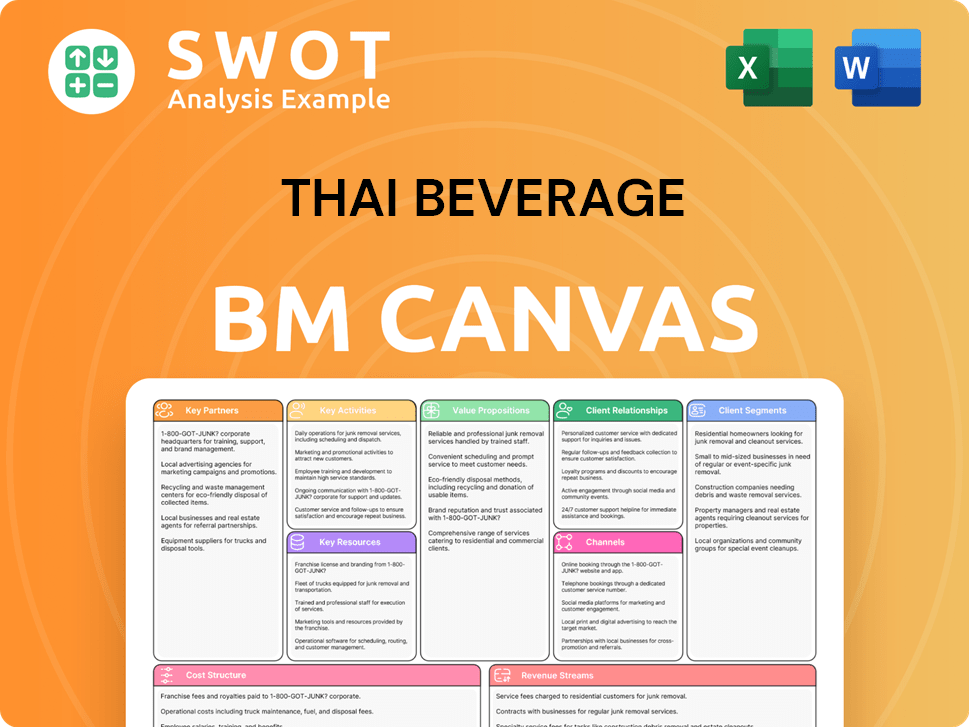
What is the Timeline of Key Events for Thai Beverage?
The Thai Beverage Company's journey, marked by strategic foresight, began with its establishment in 2003, consolidating various spirits and beer businesses. This marked the genesis of what would become a significant player in the Thai alcohol industry. The company's growth trajectory includes pivotal moments such as its listing on the Singapore Exchange (SGX) in 2006, which fueled its expansion. Further diversification into non-alcoholic beverages and strategic acquisitions, including a major stake in Fraser and Neave, Limited (F&N) in 2012-2013, underscored its ambition. The acquisition of Saigon Beer-Alcohol-Beverage Corporation (Sabeco) in 2017 significantly boosted its beer market share, particularly impacting the Chang beer brand, and the company celebrated its 20th anniversary in 2023, reflecting on its market leadership. This Thai business history is a testament to its strategic vision.
| Year | Key Event |
|---|---|
| 2003 | Thai Beverage Public Company Limited was established, consolidating various spirits and beer businesses under one entity. |
| 2006 | ThaiBev listed on the Singapore Exchange (SGX), raising significant capital for expansion. |
| 2008 | The company expanded its non-alcoholic beverage portfolio, entering new segments like ready-to-drink teas and coffees. |
| 2012-2013 | ThaiBev made a significant investment in Fraser and Neave, Limited (F&N), expanding its reach into dairy, publishing, and packaging industries across Southeast Asia. |
| 2016 | ThaiBev continued its regional expansion, increasing its presence in Vietnam and other ASEAN markets. |
| 2017 | The company completed the acquisition of a majority stake in Saigon Beer-Alcohol-Beverage Corporation (Sabeco) in Vietnam, significantly boosting its beer market share in the region. |
| 2018 | Further integration and optimization of its newly acquired assets, focusing on synergy realization. |
| 2020-2021 | Navigating the challenges of the global pandemic, ThaiBev focused on digital transformation and supply chain resilience. |
| 2023 | ThaiBev celebrated its 20th anniversary, reflecting on its growth and market leadership. |
| 2024-2025 | The company continues to focus on premiumization of its products and sustainable practices across its operations. |
ThaiBev aims to fortify its position in Southeast Asia. This involves a strategic expansion of its product offerings, particularly in the premium segments of both alcoholic and non-alcoholic beverages. The company is leveraging its extensive distribution networks for enhanced market penetration. Moreover, supply chain efficiencies are a key focus area.
ThaiBev is actively exploring strategic mergers and acquisitions. These activities are aligned with its vision of becoming a leading integrated food and beverage company within ASEAN. The company is likely to consider opportunities that complement its existing portfolio and enhance its market presence. This strategy is aimed at sustained growth and market dominance.
ThaiBev is adapting to significant industry trends. These include the rising demand for healthier beverage options and sustainable packaging solutions. E-commerce growth presents another key area of focus for the company. The company is committed to sustainability and innovation, aligning with global trends.
Analyst predictions suggest a stable outlook for ThaiBev, supported by its diversified portfolio and robust regional presence. Projected revenue growth is expected, driven by economic recovery and increased consumer spending in key markets. This forward-looking approach remains consistent with its foundational vision.
Thai Beverage Porter's Five Forces Analysis
- Covers All 5 Competitive Forces in Detail
- Structured for Consultants, Students, and Founders
- 100% Editable in Microsoft Word & Excel
- Instant Digital Download – Use Immediately
- Compatible with Mac & PC – Fully Unlocked
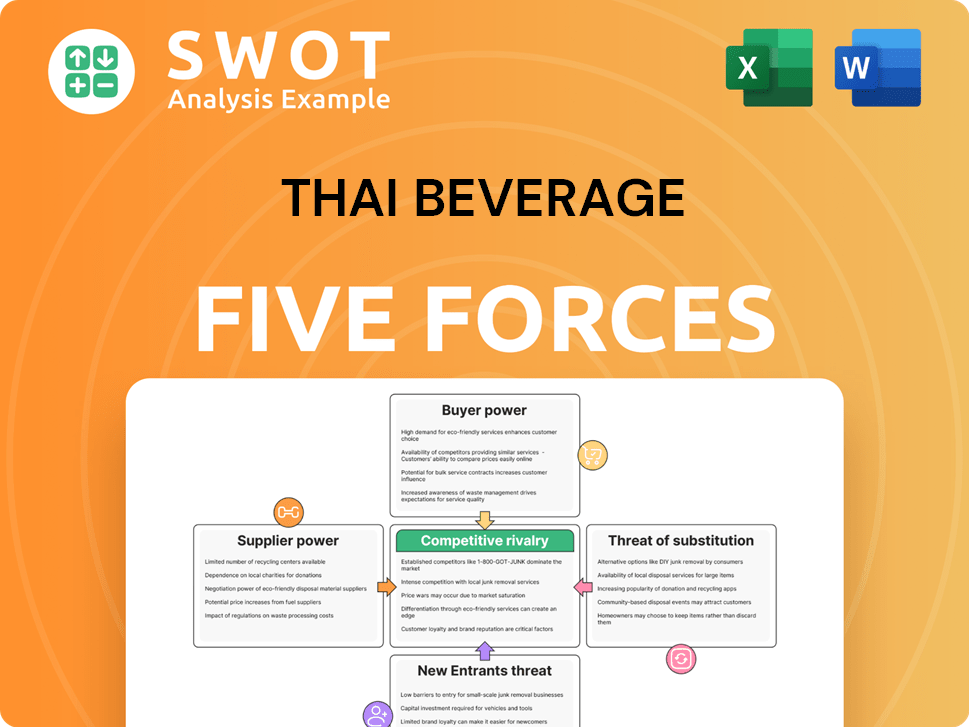
Related Blogs
- What is Competitive Landscape of Thai Beverage Company?
- What is Growth Strategy and Future Prospects of Thai Beverage Company?
- How Does Thai Beverage Company Work?
- What is Sales and Marketing Strategy of Thai Beverage Company?
- What is Brief History of Thai Beverage Company?
- Who Owns Thai Beverage Company?
- What is Customer Demographics and Target Market of Thai Beverage Company?
Disclaimer
All information, articles, and product details provided on this website are for general informational and educational purposes only. We do not claim any ownership over, nor do we intend to infringe upon, any trademarks, copyrights, logos, brand names, or other intellectual property mentioned or depicted on this site. Such intellectual property remains the property of its respective owners, and any references here are made solely for identification or informational purposes, without implying any affiliation, endorsement, or partnership.
We make no representations or warranties, express or implied, regarding the accuracy, completeness, or suitability of any content or products presented. Nothing on this website should be construed as legal, tax, investment, financial, medical, or other professional advice. In addition, no part of this site—including articles or product references—constitutes a solicitation, recommendation, endorsement, advertisement, or offer to buy or sell any securities, franchises, or other financial instruments, particularly in jurisdictions where such activity would be unlawful.
All content is of a general nature and may not address the specific circumstances of any individual or entity. It is not a substitute for professional advice or services. Any actions you take based on the information provided here are strictly at your own risk. You accept full responsibility for any decisions or outcomes arising from your use of this website and agree to release us from any liability in connection with your use of, or reliance upon, the content or products found herein.